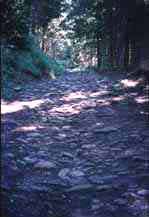
| Welcome
|
la Via countries, maps itineraries documentation | aims/partners presentation research events become a friend | diaries advice | search our site external links email us |
 |
ASSOCIATION VIA FRANCIGENA
|
 |
The so called "Lombard Way" became the Iter Francorum, or the "Frankish Route" in the Itinerarium sancti Willibaldi of 725 A.D. The "Via Francigena" is first mentioned in the Actum Clusio, a parchment in the abbey of San Salvatore al Monte Amiata (Tuscany), in 876 AD. It is the major pilgrim's route from the north of Europe to Rome, it became increasingly more popular after the institution of Holy Years in 1300.
Click here for a map of pilgrimage routes in Europe (206kB)
Click here for a map of Rome as seen by a 9th-century monk from Einsiedeln in Switzerland. (117kB)
The route of the Via Francigena was written down by a 10th-century archbishop of Canterbury called Sigeric or Sigerico on his return from Rome. Click here for a map of his route; click here for a photograph of the original manuscript and a transcription of the Latin, listing the stages of his journey. The 10th-century placenames listed here are also listed together with their modern placenames in the useful addresses section of this website.
Sigeric by Peter Robins
Statue in Glastonbury by Heather Burnley with pilgrim Andrew
More descriptions on Giovanni Caselli's website
TESTIMONIUM Peregrinatoris ad Limina Petri a parchment in limited edition, created and offered by AVF, will be given at the sacristy of St-Peter's Basilica, if possibile by Don Bruno Vercesi,to pilgrims that walked at least from Acquapendente (130km) or cycled from Lucca (400km)